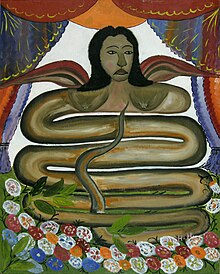Damballa
Damballa | |
|---|---|
 Veve for Damballa and Ayida-Weddo | |
| Venerated in | Haitian Vodou, Folk Catholicism |

Damballa, also spelled Damballah, Dambala, Dambalah, among other variations (Template:Lang-ht), is one of the most important of all loa, spirits in Haitian Vodou and Louisiana Voodoo traditions. He is portrayed as a great white serpent, originating in the city of Wedo (Whydah or Ouidah) in modern-day Benin.[1] Damballa is said to be the Sky Father and the primordial creator of all life, or the first thing created by Gran Met. In those Vodou societies that view Damballa as the primordial creator, he created the cosmos by using his 7,000 coils to form the stars and the planets in the heavens and to shape the hills and valleys on earth. In others, being the first thing created by God, creation was undertaken through him. By shedding the serpent skin, Damballa created all the waters on the earth. As a serpent, he moves between land and water, generating life, and through the earth, uniting the land with the waters below.[2] Damballa is usually syncretized with either Saint Patrick or Moses.[3] He is counted among the Rada loa.
Damballa is seen as benevolent and patient, wise and kind, yet detached and removed from the trials and tribulations of daily, human life. His very presence brings peace, and he represents a continuum which is "at once the ancient past and the assurance of the future."[4] As a serpent, and due to his extreme age, he does not speak, but may whistle or make a soft, hissing sound.[2]
When a serviteur is believed to be possessed by Damballa during a ceremony, he or she moves on the floor like a serpent. A white sheet is laid down for him, and another waved over him to fan and cool him. His purity is such that it cannot be allowed to be exposed to impure or unclean things.[2][5] Some peristyles maintain a basin full of water into which the possessed will plunge, to swim and cool off. Offerings to him include milk, white foods and flowers, rice, coconut, orgeat syrup, and a perfume called lotion pompeia. However his offering par excellence is a white, uncooked egg on a mound of white flour.[5]
Damballa, like many other loa, is subdivided into different spirits who play different roles. For example, as Damballa Tocan he is a spirit of the intellect. When he manifests in the Petro rites it is Damballa La Flambo.
Damballa's wife is Ayida-Weddo, although in some Vodou societies she is his sister, and in others Damballa himself after a different fashion. Erzulie Freda is his lover,[6] although, once again, she may be considered his wife in some societies.
See also
References
- ^ Chita Tann, Mambo (2012). Haitian Vodou. Woodbury, MN: Llewellyn Books. p. 99. ISBN 978-0-7387-3069-1.
- ^ a b c McCarthy Brown, Karen (1991). Mama Lola: a Vodou Priestess in Brooklyn. Berekley, CA: University of California Press. p. 274. ISBN 978-0-520-26810-4.
- ^ Perrault, Alix. "Vodou and the Loas". The Vodou Element. Archived from the original on 2014-11-07.
- ^ Deren, Maya (1953). Divine Horsemen: The Living Gods of Haiti. New York: Mcpherson and Company. p. 115.
- ^ a b Chita Tann, Mambo (2012). Haitian Vodou. woodbury, MN: Llewellyn Books. p. 212. ISBN 978-0-7387-3069-1.
- ^ Leah Gordon (1985), page 62 The Book of Vodou, Barron's Educational Series ISBN 978-0-7641-5249-8.
